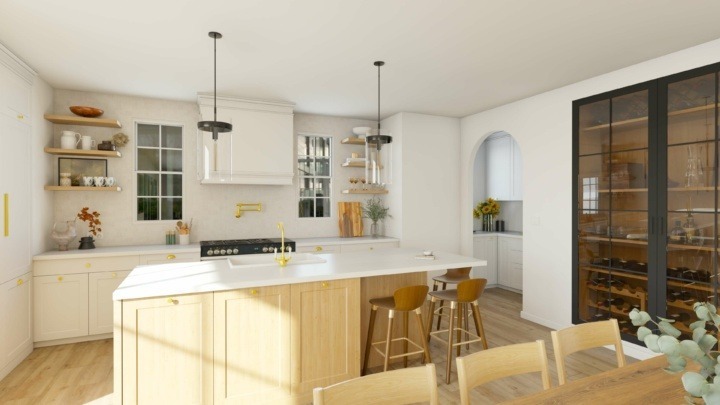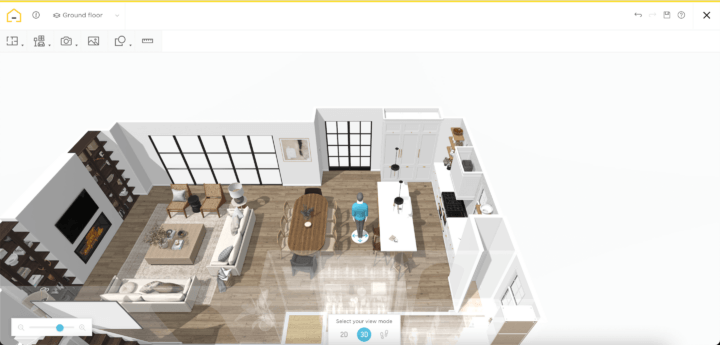How to Design a Kitchen Floor Plan?

Update the style of your home interior
Instantly test different designs and layouts
View your home in 3D before making purchases
You know what you want from your kitchen layout, so why not design it yourself? Find out how to create a kitchen floor plan with a free online tool that lets you take charge of your remodel.
The kitchen commands our attention more than any other room at home because it plays a central role in our daily lives. And that role is constantly changing. What was once viewed and used simply as a culinary hub has evolved into a space that’s dedicated to socializing, working, dining, and more. So, when it’s time to design a kitchen floor plan for your home, it deserves some careful planning. Below, we take you through the steps to show you how to create a detailed plan using a free kitchen layout design tool.
How to Create Your Kitchen Floor Plans
With the correct measurements and some inspiring ideas, you can begin designing your kitchen floor plans today in the HomeByMe tool. In this free online planner, you can develop a precise 3D rendering of your space by dragging and dropping flooring, cupboards, tables, chairs, and more into your virtual kitchen to compose your design in detail.
Being able to see and examine your ideas instantly helps you prioritize your wants versus needs, while learning how to cultivate your kitchen layout into something you’ll use and enjoy. Here is a step-by-step guide to develop your floor plan.
Design Your Kitchen Floor Plan
1
Add Walls and Measurements
You’ll need the measurements of your existing or future kitchen layout to begin drafting your outline.
With your measurements on hand, you can start inserting the walls of your kitchen and setting the correct measurements as you go. This will form the foundation and 2D diagram of your layout.
Windows, doorways, appliances, and any permanent features should be positioned in your floor plan at this stage too.
2
Build and Design in 3D
HomeByMe can automatically convert your 2D diagram into a realistic 3D format with a simple click.
From here, you can select from the catalog of products and materials to design your dream kitchen. Select custom cabinetry, sinks and faucets, lighting, tiles, and furniture.
Every type of product you need is available to add, view, and assemble in your design.
3 Take a Virtual Walkthrough
See if there’s enough room to comfortably walk around the kitchen and get a genuine impression of how it will appear in reality by taking a virtual walkthrough.
To use your design for future reference, save 360° snapshots to keep tabs from every angle.
Let others see and experience a realistic mockup too by sharing a link of your newly crafted layout.
Floor Plan Kitchen Layout Tips
A good kitchen layout is all about building a space that can keep up with your lifestyle while still looking great. Consider these floor plan kitchen layout tips to strike the right balance with your design.
Prioritize Ergonomics
Ergonomics should be given just as much attention as the aesthetics when drafting your floor plan kitchen layout. Having a practical setup will not only make it easier to navigate when you’re in the kitchen, but it can also make it more enjoyable for everyone. In your plan, focus on placing major features – fridge, stove, and sink – within close proximity. Consider storage options once these are established. Large pull-out cabinets and drawers are excellent options to house major cookware.
If you have a brightly lit area near a window, this is a great option for a seating area. With HomeByMe, you can play around with each component to explore new ways to balance practicality with aesthetics.
Ensure Measurements are Accurate
Accurate measurements are crucial to ensure everything will fit seamlessly into your kitchen. When planning your space, you’ll also need those measurements to determine if there’s enough room to preserve the flow throughout the kitchen. Whether it’s hiring a professional or double-checking your dimensions, make sure that they are clear and exact.
Once you have your measurements, you can add them to your 3D kitchen floor planner to create your outline with precision and confidence.
Consider Symmetry and Size of Cabinetry
As a bulky feature in the kitchen, cabinetry is an important element to choose carefully. Specifically, the size and symmetry must be considered in conjunction with the style. For example, when using tall units, try to keep these close to the ceiling to avoid or minimize any gaps that can create an unbalanced appearance. Standard cabinets typically measure 600mm wide, but you can consider customized ones too.
Try out different options in the HomeByMe catalog, including premade and bespoke cabinetry.

The Best Floor Plans for a Kitchen
We break down three of the best floor plans for a kitchen that are used by designers. Each of these can be implemented into your digital 3D kitchen floor plan. Test and compare to see which works best for you.
The U Shape Kitchen Layout
The U shape is among the most widely used kitchen layouts because it can work for any size. As the name implies, the U offers a central area, which is usually a kitchen island that acts as an anchor. The two longer sides can accommodate lots of cabinetry and storage space. It’s a great option for those who love to cook and entertain at the same time.
The L Shape Kitchen Layout
Larger kitchens are ideal for the L shape kitchen layout. With two adjoining walls that resemble an L, this shape is ideal for maximizing the usability of counters, storage, and dining. There are many ways to configure this shape to suit your needs. You could consider adding a breakfast nook or a second kitchen island with more seating.
The Galley Kitchen Layout
With two long and narrow parallel walls featured in this design, the galley kitchen layout is typically what you would find in smaller interiors. This isn’t the best option if you plan on having multiple cooks in the kitchen at the same time. However, it is an excellent layout if you’re limited and want to create as much counter space as possible.
Small Kitchen Floor Plans
Before you begin designing your small kitchen floor plans, be clear on your priorities and consider these smart solutions below to prevent clutter.
Focus on Height
There’s a general rule of thumb used for maximizing the full potential of smaller spaces – focus on using height. A wall oven, wall cabinets, or a tall pantry are good examples of this. So, make sure to look upward when drafting your plans.
Think About Appliances
Be smart about the appliances you choose. A flat induction stove might make more sense than a gas burner because you can use it as an additional prep area for cooking. Save room for more storage by choosing a compact microwave, or having one built into your cabinetry.
Add A Kitchen Island
Kitchen islands can serve many purposes in smaller kitchens. It will give you extra space to chop, cook and socialize. So, if there is room, consider adding one. Check out different sizes and styles in the HomeByMe catalog.
Determining the best way to construct your kitchen requires an acute balance between functionality and style. With HomeByMe to support your ideas, you can achieve a design that’s fully customized for you and hits all the right notes. To discover a range of unique and professional designs, view our inspiration corner and see how you can design a stunning space all on your own.
Are you designing a kitchen project? Plan your home design from start to finish using our simple online software.
Update the style of your home interior
Instantly test different designs and layouts
View your home in 3D before making purchases
Draw your Kitchen now!
